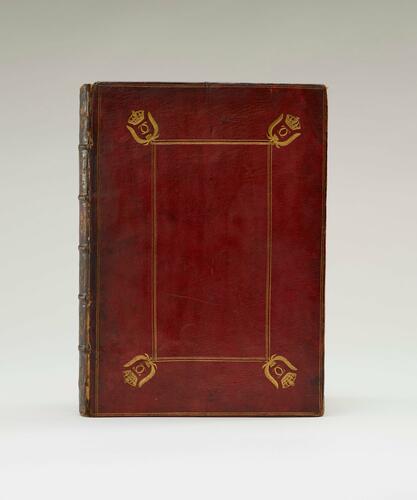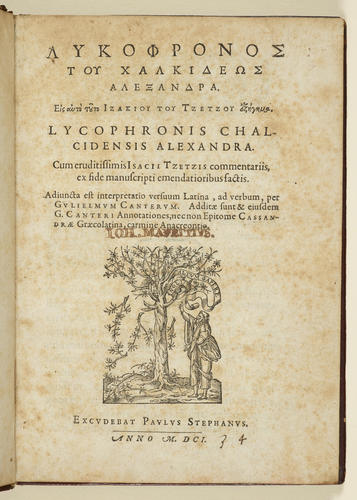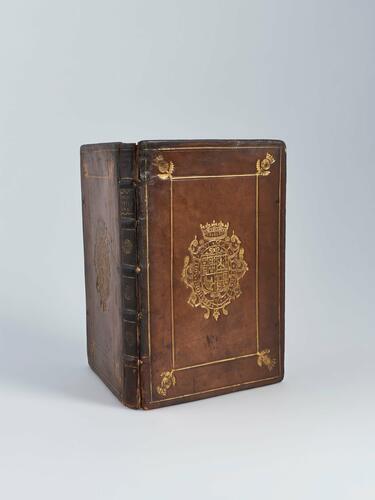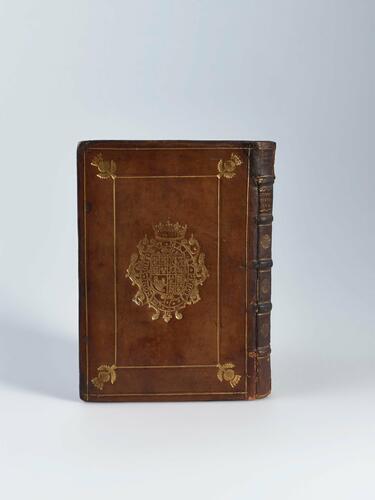Lycophronis Chalcidensis Alexandra / cum eruditissimis Isaacii Tzetzis commentariis, ex fide manuscripti emendatoribus factis ; adiuncta est interpretatio versuum Latina, ad verbum, per Gulielmum Canterum ... 1601
23.4 x 17.7 x 2.2 cm (book measurement (conservation)) | RCIN 1086423

Lycophron (b. c. 320 BC)
Lycophronis Chalcidensis Alexandra / cum eruditissimis Isaacii Tzetzis commentariis, ex fide manuscripti emendatoribus factis ; adiuncta est interpretatio versuum Latina, ad verbum, per Gulielmum Canterum . . 1601

Lycophron (b. c. 320 BC)
Lycophronis Chalcidensis Alexandra / cum eruditissimis Isaacii Tzetzis commentariis, ex fide manuscripti emendatoribus factis ; adiuncta est interpretatio versuum Latina, ad verbum, per Gulielmum Canterum . . 1601

Lycophron (b. c. 320 BC)
Lycophronis Chalcidensis Alexandra / cum eruditissimis Isaacii Tzetzis commentariis, ex fide manuscripti emendatoribus factis ; adiuncta est interpretatio versuum Latina, ad verbum, per Gulielmum Canterum . . 1601




-
This 1601 edition of Lycophron's Alexandra or Cassandra was published by Paul Estienne (b. 1567), son of the noted French classical scholar and printer Henri Estienne (c. 1531-98). Cassandra is an epic poem that recounts a prophecy of the Trojan seer Cassandra, which explores the later history of the Greeks and Trojans following the sack of Troy.
The volume is typical of the Estienne manufactory with its dedication to printing high quality editions of Classical works with extensive commentaries. This book uses the commentary of the twelfth-century Byzantine scholars John and Isaac Tzetzes. Lycophron's poem is renowned for its difficulty and the commentary of the Tzetzes brothers is one of the most comprehensive.
The title page has been signed by the seventeenth century book collector, John Morris (d. 1658) and was one of the books acquired by Charles II following his accession to the throne after the Restoration of 1660. The King had the book re-bound in an elegant minimalist style typical of other books acquired from Morris's library. The style, with a central panel and the cypher of Charles II (a crowned pair of addorsed Cs between pair of palm fronds) in each corner and on the spine, is very similar to those produced by Samuel Mearne for Charles II during the years 1663 to 1667.
The initials ‘I.M’ [John Morris] that are tooled in the tail-most compartment are probably contemporary with the transfer of the book to the British Museum before being sold in the duplicate sale, rather than an addition made while the book was in the Old Royal Library.
Binding informationContemporary red goatskin binding; gold-tooling throughout.
Identical ‘panel’ design on both sides, formed of an outer double fillet border and inner triple fillet border. Cypher of Charles II (a crowned pair of addorsed Cs between pair of palm fronds) tooled on each corner of central panel.
Roll with leaf design on all edges of both boards.
Spine divided into six compartments by raised bands, each compartment containing a double fillet border. Second compartment lettered: ‘LYCO- PHRON 1601’, with the other compartments containing a smaller Charles II cypher to that used on the left and right boards. Initials ‘I.M’ tooled in the tail-most compartment, contemporary with the transfer of the book to the British Museum before being sold in the duplicate sale.
This binding is very similar to those produced by Samuel Mearne for Charles II during the years 1663 to 1667. Nixon and Foot have divided these Mearne bindings into three stylistic group, the third comprising of bindings with a ‘gold-tooled panel with the royal cypher at the corners as well as in the panels of the spine. This is in the normal style for quartos and folios.’ (see Nixon and Foot, Decorated Bookbinding, p. 65 and fig. 51). Add B 36.6 fits well with this group. Other bindings identified as part of this group include BL C 83 e 6.
Provenance
Purchased by Charles II as part of the library of John Morris (d. 1658), the first major acquisition to the Old Royal Library at St James's Palace following the Restoration in 1660. Presented to the nation by George II, sold as a duplicate by the British Museum in 1819 (Lot no. 1092), though it bears the bookstamp of the 1818 sale, where it was bought by the bookseller Thomas Thorpe (1791-1851) for 7s 6d. It was acquired for the Royal Library before 1860.
-
Creator(s)
(printer) -
Measurements
23.4 x 17.7 x 2.2 cm (book measurement (conservation))
Category
Alternative title(s)
Alexandra. Greek and Latin
Place of Production
Paris [Île-de-France]








